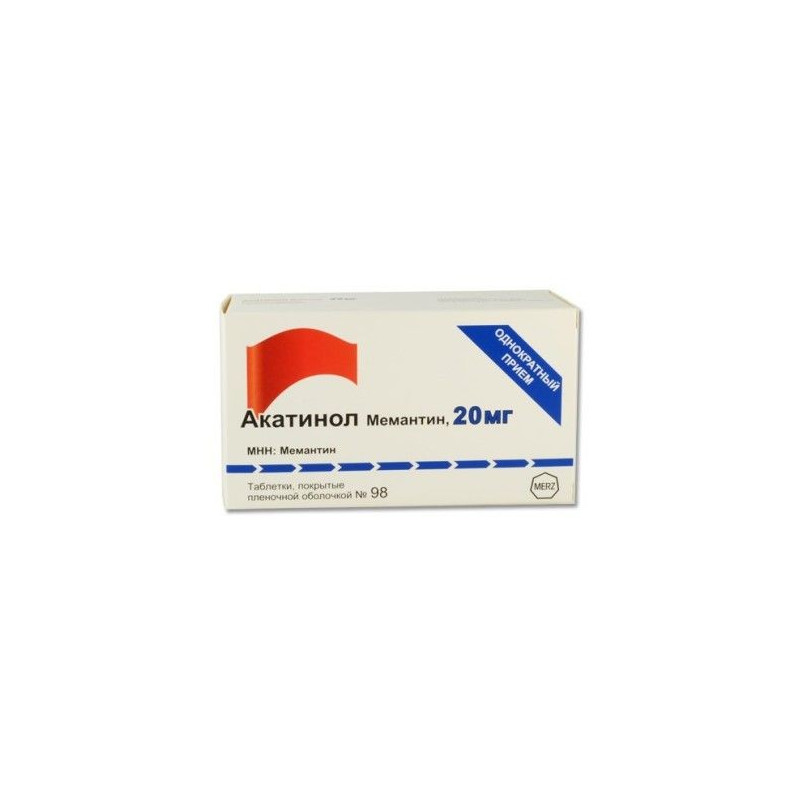



 All payments are encrypted via SSL
All payments are encrypted via SSL
 Full Refund if you haven't received your order
Full Refund if you haven't received your order
Composition
In 1 tablet, film coated, contains:
Microcrystalline cellulose 263.5 mg, croscarmellose sodium 13.5 mg, colloidal silicon dioxide 1.5 mg, Magnesium stearate 1.5 mg.
Opadray pink 12 mg: hypromellose 7.5 mg, titanium dioxide (E 171) 3.3984 mg, macrogol 400: 0.75 mg, red iron oxide (E 172) 0.2004 mg, yellow iron oxide (E 172) 0, 1512 mg.
In a blister pack of 14 tablets. In a cardboard bundle 7 blister packs.
Indications for use
Pharmacokinetics
After ingestion is quickly and completely absorbed.
The maximum concentration in a blood plasma is reached within 2 - 6 hours. In normal renal function, no accumulation of the drug was observed.
Metabolites do not possess their own pharmacological activity.
Excreted by the urine. With alkaline urine, excretion slows down. About 80% of Memantine is excreted unchanged.
Withdrawal proceeds in two phases. The half-life in the first phase is 4 to 9 hours, in the second phase it is 40 to 65 hours.
Clinical Pharmacology
Derived adamantane.
Being a noncompetitive antagonist of N - methyl - D - aspartate (NMDA) receptors, reduces the excessive stimulating effect of cortical glutamate neurons on the neostriatum.
It regulates ion transport, blocks Calcium channels, normalizes membrane potential, improves the transmission of nerve impulses. It improves cognitive processes, memory and learning ability, increases daily activity.
Use during pregnancy and lactation
Contraindicated in pregnancy and during breastfeeding.
Caution should be assigned:
Adverse reactions are classified by clinical manifestations (according to the lesion of certain organ systems) and by frequency of occurrence:
Vertigo (vertigo; synonym - vertigo) is a term that is used to designate a distorted perception of the position of one’s body in space, a feeling of imaginary movement of one’s own body or the environment. For details, see the article dizziness, drowsiness, irritability, fatigue, anxiety, increased intracranial pressure, nausea, hallucinations, headache, impaired consciousness, muscle hypertonia, gait disturbance, Depression (from Latin. depressio - suppression) - a mental disorder, which is referred to as affective disorders (mood disorders). D.characterized by depressed sad mood with negative, pessimistic self-esteem of his position and future, a sense of abandonment, which is combined with anxiety, decreased psychomotor activity, fatigue, somatoform manifestations (loss of appetite, weight loss, constipation, decreased libido), sleep disorders., convulsions, psychotic reactions, suicidal thoughts, constipation, vomiting, pancreatitis, candidiasis, increased blood pressure, cystitis, increased libido, venous thrombosis, thromboembolism, allergic reactions.
Often - a headache.
Rarely - fatigue.
Rarely - fungal infections.
Often - drowsiness.
Rarely - confusion, hallucinations.
Hallucinations were observed mainly in patients with Alzheimer's disease (A. Alzheimer, 1864-1915, German. Doctor) - a type of presenile dementia, manifested, along with the progressive development of amnestic dementia, aphasic, apraxic and agnostic disorders. at the stage of severe Dementia (Latin dementia - insanity, insanity, synonym - dementia) - acquired as a result of organic destruction of the large hemispheres of the brain, a decrease in intelligence (characterized by simultaneous breakdown of several cognitive functions), which violates social adaptation. Diagnosis and treatment of D. depend on the underlying disease..
Rarely - increased blood pressure, venous thrombosis, thromboembolism.
Often - constipation.
Rarely - nausea and vomiting.
Pancreatitis - frequency not set.
Often - Vertigo (vertigo; synonym - vertigo) - a term which is used to designate a distorted perception of the position of one’s body in space, a feeling of imaginary movement of one’s own body or the surrounding environment. See the Vertigo article for more details.
Rarely - nausea and vomiting.
Very rarely - cramps.
Interaction
With simultaneous use with levodopa preparations, dopamine receptor antagonists, m-anticholinergic drugs, the action of the latter can be enhanced.
With simultaneous use with barbiturates, neuroleptics, the effect of the latter may be reduced.
When used together, it can change (increase or decrease) the effect of dantrolene or Baclofen, so the doses of drugs should be selected individually.
Concurrent administration with amantadine, ketamine, phenytoin and dextromethofan should be avoided due to the increased risk of developing psychosis.
May increase INR in patients taking oral anticoagulants (warfarin).
Simultaneous use with antidepressants, selective serotonin reuptake inhibitors and monoamine oxidase inhibitors requires careful monitoring of patients.
Overdose
Dosage and administration
The drug should be taken orally once a day and always at the same time, regardless of the meal.
The maximum daily dose of 20 mg.
In patients older than 65 years, as well as patients with creatinine clearance of 50 - 80 ml / min, dose adjustment is not required.
For patients with moderate renal insufficiency (creatinine clearance 30–49 ml / min), the daily dose is 10 mg.
In the future, with good tolerability of the drug for 7 weeks, the dose can be increased to 20 mg according to the standard scheme.
Precautionary measures
In patients with Alzheimer's disease (A. Alzheimer, 1864-1915, German. Doctor) is a type of presenile dementia, manifested, along with the progressive development of amnesic dementia, aphasic, apraxic and agnostic disorders. at the stage of moderate and severe Dementia (Latin dementia - insanity, insanity, synonym - dementia) - acquired as a result of organic lesion of the big hemispheres of the brain, a decrease in intelligence (characterized by simultaneous breakdown of several cognitive functions), violating social adaptation. Diagnosis and treatment of D. depend on the underlying disease. usually impaired ability to drive vehicles and management of complex mechanisms.
In addition, memantine can cause a change in the reaction rate, so patients should refrain from driving or working with complex mechanisms.
Storage conditions